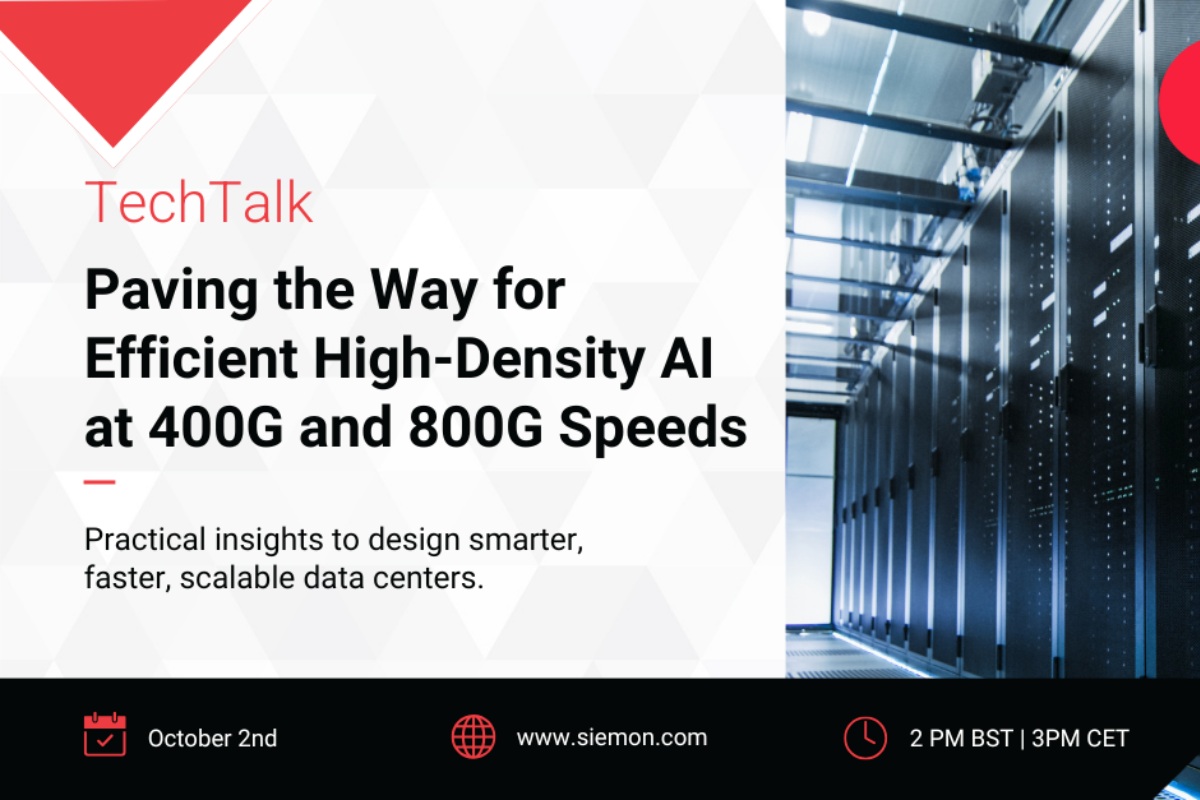Data Centre Operations: Optimising Infrastructure for Performance and Reliability
Artificial Intelligence in Data Centre Operations
Data Centre Operations: Optimising Infrastructure for Performance and Reliability
Sponsored
AI infrastructure as Trojan horses for climate infrastructure
Data centres are getting bigger, denser, and more power-hungry than ever before. The rapid rise of artificial intelligence (AI) is accelerating this expansion, driving one of the largest capital build-outs of our time. Left unchecked, hyperscale growth could deepen strains on energy, water, and land - while concentrating economic benefits in just a few regions. But this trajectory isn’t inevitable.
In this whitepaper, Shilpika Gautam, CEO and founder of Opna, explores how shifting from training-centric hyperscale facilities to inference-first, modular, and distributed data centres can align AI’s growth with climate resilience and community prosperity.
The paper examines:
• How right-sized, locally integrated data centres can anchor clean energy projects and strengthen grids through flexible demand,
• Opportunities to embed circularity by reusing waste heat and water, and to drive demand for low-carbon materials and carbon removal, and
• The need for transparency, contextual siting, and community accountability to ensure measurable, lasting benefits.
Decentralised compute decentralises power. By embracing modular, inference-first design, AI infrastructure can become a force for both planetary sustainability and shared prosperity.
You can download the whitepaper for yourself by clicking this link.
Joe Peck - 16 October 2025
Data Centre Operations: Optimising Infrastructure for Performance and Reliability
Edge Computing in Modern Data Centre Operations
News
Duos Edge AI expands edge DC network in Texas
Duos Technologies Group, through its subsidiary Duos Edge AI, a provider of edge data centre (EDC) systems, has deployed a new EDC in Waco, Texas, at the Education Service Centre (ESC) Region 12.
The facility marks the company’s sixth site in the state and aims to strengthen digital infrastructure to support local education and community development.
The project aims to expand access to reliable, low-latency computing for schools and community partners, providing the resources needed to deliver modern digital learning tools and services.
Supporting distributed computing and digital learning
The partnership with Region 12 highlights the increasing demand for distributed computing infrastructure to enable K–12 education, workforce development, and regional digital transformation across Texas.
The new edge data centre seeks to enhance bandwidth, secure data processing, and local AI capabilities, improving connectivity and efficiency throughout the region.
Doug Recker, President of Duos and Duos Edge AI, comments, “This deployment is a significant advancement in our statewide initiative to bring modern computing capabilities closer to where data is created and used.
"Our collaboration with Region 12 strengthens the foundation for next-generation learning tools, administrative efficiency, and community connectivity - all powered locally at the edge.”
Kenny Berry, Executive Director of ESC Region 12, adds, “Access to real-time, reliable data processing directly supports our educators and students.
"This edge data centre brings long-term value to our schools by enabling advanced learning technologies, improving efficiency, and reducing latency across our network.”
The deployment forms part of Duos Edge AI’s 2025 strategy to establish 15 operational edge data centres. Each facility features a modular design for rapid deployment, offering scalable compute power and high-speed connectivity in as little as 90 days.
These sites, the company says, are helping meet the evolving digital needs of the education, healthcare, and government sectors.
For more from Duos Edge AI, click here.
Joe Peck - 9 October 2025
Artificial Intelligence in Data Centre Operations
Data Centre Business News and Industry Trends
Data Centre Training & Certification Programs
News
Saudi Arabia’s first integrated data science and AI diploma
DataVolt, a Saudi Arabian developer and operator of sustainable data centres, has partnered with the Energy & Water Academy (EWA) and Innovatics to launch the Kingdom of Saudi Arabia’s first fully industry-integrated Diploma in Data Science and Artificial Intelligence (AI).
The new programme is designed to blend academic learning with practical, real-world experience, helping to prepare Saudi talent for the digital economy.
Announced at the LEARN event in Riyadh, the Diploma is approved by the Technical and Vocational Training Corporation (TVTC) and College of Excellence (CoE), and endorsed by the Ministry of Communications and Information Technology (MCIT).
It is also supported by the Human Resources Development Fund (HRDF).
Unlike traditional academic pathways, the programme combines classroom study with applied projects.
Students will work with sponsoring companies, including DataVolt, on live industry challenges, developing proof-of-concept AI applications and gaining hands-on experience that directly aligns with workforce needs.
As part of its commitment, DataVolt will sponsor five students from the first cohort and guarantee them employment after graduation. They will join the company’s operations supporting high-power-density workloads at its data centres, including its planned AI campus in Oxagon, NEOM.
DataVolt is inviting other organisations to co-sponsor the inaugural class of 100 students, with a target of 50% female participation. The first intake is scheduled to begin in November 2025.
Industry-led learning for the digital future
Rajit Nanda, CEO at DataVolt, says, “DataVolt is not only building the Kingdom’s next-generation data centres, but also the local Saudi talent to power them, ensuring the country is prepared to lead the global AI economy in the long term.
"Our investment in this first-of-its-kind Diploma demonstrates our commitment to Vision 2030 and we encourage our partners across the industry to join us in sponsoring the programme and future-proofing the local workforce.”
With AI expected to contribute around US$320 billion (£239.1 billion) to the Middle East economy by 2030, and Saudi Arabia set to see the greatest share of that value, the initiative supports the country’s Vision 2030 and the National Strategy for Data and AI (NSDAI).
The programme aims to help bridge the national skills gap and contribute to the target of training 20,000 AI professionals over the next five years.
Salwa Smaoui, CEO of Innovatics, comments, “This Diploma is not just education; it is a strategic workforce initiative. Our mission is to ensure every graduate is ready to contribute from day one to the Kingdom’s most ambitious AI projects.”
Tariq Alshamrani, CEO of EWA, adds, “EWA is proud to partner with DataVolt and Innovatics to deliver this programme. Together, we are developing the next generation of data scientists and AI professionals who will power the Kingdom’s digital future.”
DataVolt continues to expand its data centre footprint across Saudi Arabia. Earlier this year, the company signed an agreement with NEOM to design and develop the region’s first sustainable, net-zero AI campus in Oxagon.
The first phase of the 1.5 GW development, backed by an initial investment of US$5 billion (£3.7 billion), is expected to begin operations in 2028.
For more from DataVolt, click here.
Joe Peck - 9 October 2025
Artificial Intelligence in Data Centre Operations
Data Centre Operations: Optimising Infrastructure for Performance and Reliability
Events
Sponsored
Paving the way for efficient high-density AI at 400G & 800G
AI workloads are reshaping the data centre. As back-end traffic scales and racks densify, the interconnect choices you make today will determine the performance, efficiency, and scalability of tomorrow’s AI infrastructure.
In this fast, focused 30-minute live tech talk, Siemon’s experts will share a practical, cabling-led view to help you plan smarter and deploy faster.
Drawing on field experience and expectations from large-scale AI deployments, the session will give you clear context and actionable guidance before your next design, upgrade, or AI back-end project begins.
Discover:
• AI market overview & nomenclature: A clear look at scale-up vs scale-out networks and where each fit in AI planning.
• Reference designs & deployment sizes: Common GPU pod approaches (including air-cooled and liquid-to-chip) and what they mean for density and footprint.
• AI network connection points: Critical interconnect considerations for high-performance AI back-end networks.
• AI network cabling considerations: What to evaluate when selecting cables for demanding 400G/800G workloads.
• Cabling options that improve efficiency: Real-world examples of how architecture choices affect deployment efficiency, including a 1024-GPU comparison.
Walk away with:
• A clear understanding of high-density interconnect options.
• Insight into proven deployment strategies and the trade-offs that matter.
• Confidence to make informed decisions that scale with AI workloads.
Speaker: Ryan Harris, Director, Systems Engineering (High-Speed Interconnect), SiemonDate: Thursday, 2 October 2025Time: 2:00–2:30 PM BST | 3:00–3:30 PM CET
This is the must-see tech talk for anyone planning, designing, or deploying high-density AI data centres. Don’t miss your chance to get the insight that can accelerate your next project and keep your infrastructure ready for the demands ahead.
Register now via this link to secure your spot.
For more from Siemon, click here.
Joe Peck - 29 September 2025
Artificial Intelligence in Data Centre Operations
Data Centre Build News & Insights
Data Centre Operations: Optimising Infrastructure for Performance and Reliability
Exploring Modern Data Centre Design
Schneider Electric unveils AI DC reference designs
Schneider Electric, a French multinational specialising in energy management and industrial automation, has announced new data centre reference designs developed with NVIDIA, aimed at supporting AI-ready infrastructure and easing deployment for operators.
The designs include integrated power management and liquid cooling controls, with compatibility for NVIDIA Mission Control, the company’s AI factory orchestration software. They also support deployment of NVIDIA GB300 NVL72 racks with densities of up to 142kW per rack.
Integrated power and cooling management
The first reference design provides a framework for combining power management and liquid cooling systems, including Motivair technologies. It is designed to work with NVIDIA Mission Control to help manage cluster and workload operations.
This design can also be used alongside Schneider Electric’s other data centre blueprints for NVIDIA Grace Blackwell systems, allowing operators to manage the power and liquid cooling requirements of accelerated computing clusters.
A second reference design sets out a framework for AI factories using NVIDIA GB300 NVL72 racks in a single data hall. It covers four technical areas: facility power, cooling, IT space, and lifecycle software, with versions available under both ANSI and IEC standards.
Deployment and performance focus
According to Schneider Electric, operators are facing significant challenges in deploying GPU-accelerated AI infrastructure at scale. Its designs are intended to speed up rollout and provide consistency across high-density deployments.
Jim Simonelli, Senior Vice President and Chief Technology Officer at Schneider Electric, says, “Schneider Electric is streamlining the process of designing, deploying, and operating advanced, AI infrastructure with its new reference designs.
"Our latest reference designs, featuring integrated power management and liquid cooling controls, are future-ready, scalable, and co-engineered with NVIDIA for real-world applications - enabling data centre operators to keep pace with surging demand for AI.”
Scott Wallace, Director of Data Centre Engineering at NVIDIA, adds, “We are entering a new era of accelerated computing, where integrated intelligence across power, cooling, and operations will redefine data centre architectures.
"With its latest controls reference design, Schneider Electric connects critical infrastructure data with NVIDIA Mission Control, delivering a rigorously validated blueprint that enables AI factory digital twins and empowers operators to optimise advanced accelerated computing infrastructure.”
Features of the controls reference design
The controls system links operational technology and IT infrastructure using a plug-and-play approach based on the MQTT protocol. It is designed to provide:
• Standardised publishing of power management and liquid cooling data for use by AI management software and enterprise systems• Management of redundancy across cooling and power distribution equipment, including coolant distribution units and remote power panels• Guidance on measuring AI rack power profiles, including peak power and quality monitoring
Reference design for NVIDIA GB300 NVL72
The NVIDIA GB300 NVL72 reference design supports clusters of up to 142kW per rack. A data hall based on this design can accommodate three clusters powered by up to 1,152 GPUs, using liquid-to-liquid coolant distribution units and high-temperature chillers.
The design incorporates Schneider Electric’s ETAP and EcoStruxure IT Design CFD models, enabling operators to create digital twins for testing and optimisation. It builds on earlier blueprints for the NVIDIA GB200 NVL72, reflecting Schneider Electric’s ongoing collaboration with NVIDIA.
The company now offers nine AI reference designs covering a range of scenarios, from prefabricated modules and retrofits to purpose-built facilities for NVIDIA GB200 and GB300 NVL72 clusters.
For more from Schneider Electric, click here.
Joe Peck - 19 September 2025
Data Centre Operations: Optimising Infrastructure for Performance and Reliability
Data Centres
Edge Computing in Modern Data Centre Operations
News
Duos deploys fifth edge data centre
Duos Technologies Group, through its operating subsidiary Duos Edge AI, a provider of adaptive, versatile and streamlined edge data centre (EDC) solutions tailored to meet evolving needs in any environment, has announced its latest data centre deployment towards its anticipated goal of 15 deployments by the year's end.
The latest EDC is in partnership with Dumas Independent School District to deploy an on-premise EDC in Dumas, Texas. This project marks another milestone in Duos Edge AI’s expansion into rural communities, providing low-latency compute and connectivity that directly support K-12 education and regional growth.
The Dumas ISD edge data centre will serve as a localised hub for real-time data processing, enabling advanced educational tools, stronger digital infrastructure, and improved connectivity for students and staff across the district.
“As Director of Information Technology for Dumas ISD, I am excited about our partnership with Duos Edge AI,” says Raymond Brady, Director of Information Technology at Dumas ISD. “This collaboration brings direct, on premise access to a cutting-edge data centre, an extraordinary opportunity for a rural community like Dumas. It will significantly strengthen the district’s technology capabilities and support our mission of achieving academic excellence through collaboration with students, parents, and the community. I look forward to working with Duos Edge AI as we continue to provide innovative technology for our students and staff, ensuring every student is prepared for success.”
“This partnership with Dumas ISD is a perfect example of how edge technology can create lasting impact in rural communities,” adds Doug Recker, newly appointed President of Duos Technologies Group and the founder of subsidiary, Duos Edge AI. “By placing powerful computing infrastructure directly on campus, we’re helping schools like Dumas unlock real-time digital tools that drive student achievement, workforce readiness, and community growth.”
This deployment is part of Duos Edge AI’s broader 2025 plan to establish 15 modular EDCs nationwide, with a focus on underserved and high-growth markets. By locating advanced computing infrastructure closer to end users, Duos Edge AI ensures reliable, secure, and scalable technological access for schools, healthcare facilities, and local communities.
For more from Duos Edge, click here.
Simon Rowley - 17 September 2025
Data Centre Operations: Optimising Infrastructure for Performance and Reliability
Data Centre Software for Smarter Operations
News
Cadence adds NVIDIA DGX SuperPOD to digital twin platform
Cadence, a developer of electronic design automation software, has expanded its Reality Digital Twin Platform library with a digital model of NVIDIA’s DGX SuperPOD with DGX GB200 systems.
The addition is aimed at supporting data centre designers and operators in planning and managing facilities for large-scale AI workloads.
The Reality Digital Twin Platform enables users to create detailed digital replicas of data centres, simulating power, cooling, space, and performance requirements before physical deployment.
By adding the NVIDIA DGX SuperPOD, Cadence says engineers can model AI factory environments with greater accuracy, supporting faster deployment and improved operational efficiency.
Digital twins for AI data centres
Michael Jackson, Senior Vice President of System Design and Analysis at Cadence, says, “Rapidly scaling AI requires confidence that you can meet your design requirements with the target equipment and utilities.
"With the addition of a digital model of NVIDIA’s DGX SuperPOD with DGX GB200 systems to our Cadence Reality Digital Twin Platform library, designers can model behaviourally accurate simulations of some of the most powerful accelerated systems in the world, reducing design time and improving decision-making accuracy for mission-critical projects.”
Tim Costa, General Manager of Industrial and Computational Engineering at NVIDIA, adds, “Creating the digital twin of our DGX SuperPOD with DGX GB200 systems is an important step in enabling the ecosystem to accelerate AI factory buildouts.
"This step in our ongoing collaboration with Cadence fills a crucial need as the pace of innovation increases and time-to-service shrinks.”
The Cadence Reality Digital Twin Platform allows engineers to drag and drop vendor-provided models into simulations to design and test data centres. It can also be used to evaluate upgrade paths, failure scenarios, and long-term performance.
The library currently contains more than 14,000 items from over 750 vendors.
Industry engagement
The addition of the NVIDIA model is part of Cadence’s ongoing collaboration with NVIDIA, following earlier support for the NVIDIA Omniverse blueprint for AI factory design.
Cadence will highlight the expanded platform at the AI Infra Summit in Santa Clara from 9-11 September, where company experts will take part in keynotes, panels, and talks on chip efficiency and simulation-driven data centre operations.
For more from Cadence, click here.
Joe Peck - 11 September 2025
Artificial Intelligence in Data Centre Operations
Data Centre Infrastructure News & Trends
Data Centre Operations: Optimising Infrastructure for Performance and Reliability
Enterprise Network Infrastructure: Design, Performance & Security
Nokia, Supermicro partner for AI-optimised DC networking
Finnish telecommunications company Nokia has entered into a partnership with Supermicro, a provider of application-optimised IT systems, to deliver integrated networking platforms designed for AI, high-performance computing (HPC), and cloud workloads.
The collaboration combines Supermicro’s advanced switching hardware with Nokia’s data centre automation and network operating system for cloud providers, hyperscalers, enterprises, and communications service providers (CSPs).
Building networks for AI-era workloads
Data centres are under increasing pressure from the rising scale and intensity of AI and cloud applications. Meeting these requirements demands a shift in architecture that places networking at the core, with greater emphasis on performance, scalability, and automation.
The joint offering integrates Supermicro’s 800G Ethernet switching platforms with Nokia’s Service Router Linux (SR Linux) Network Operating System (NOS) and Event-Driven Automation (EDA). Together, these form an infrastructure platform that automates the entire network lifecycle - from initial design through deployment and ongoing operations.
According to the companies, customers will benefit from "a pre-validated solution that shortens deployment timelines, reduces operational costs, and improves network efficiency."
Industry perspectives
Cenly Chen, Chief Growth Officer, Senior Vice President, and Managing Director at Supermicro, says, "This collaboration gives our customers more choice and flexibility in how they build their infrastructure, with the confidence that Nokia’s SR Linux and EDA are tightly integrated with our systems.
"It strengthens our ability to deliver networked compute architectures for high-performance workloads, while simplifying orchestration and automation with a unified platform."
Vach Kompella, Senior Vice President and General Manager of the IP Networks Division at Nokia, adds, "Partnering with Supermicro further validates Nokia SR Linux and Event-Driven Automation as the right software foundation for today’s data centre and IP networks.
"It also gives us significantly greater reach into the enterprise market through Supermicro’s extensive channels and direct sales, aligning with our strategy to expand in cloud, HPC, and AI-driven infrastructure."
For more from Nokia, click here.
Joe Peck - 9 September 2025
Data Centre Operations: Optimising Infrastructure for Performance and Reliability
Modular Data Centres in the UK: Scalable, Smart Infrastructure
News
Duos Edge AI awarded patent for modular DC entryway
The US Patent and Trademark Office has granted Duos Edge AI, a provider of edge data centre (EDC) systems, a patent for a new entryway design for modular data centres.
The system aims to improve security and protect mission-critical equipment by combining a two-door access configuration with filtration to reduce the intrusion of dust, dirt, and moisture.
Duos Edge AI, a subsidiary of Duos Technologies Group, develops modular edge data centres intended to provide reliable, low-latency data access in areas where traditional infrastructure is limited.
The patented entryway is designed to support these facilities in remote or rural locations by improving equipment resilience and service uptime.
Supporting communities
The company’s edge data centres are used by schools, hospitals, warehouses, carriers, and first responders. By enhancing environmental protection for infrastructure, the new design is expected to strengthen operational continuity in sectors that depend on constant access to digital services.
Doug Recker, President and founder of Duos Edge AI, says, "This patent demonstrates our commitment to delivering ruggedised, field-ready edge data centres that meet the unique needs of rural and underserved markets.
"By addressing critical challenges like environmental intrusion, we are setting a higher standard for reliability and long-term value for our customers."
The modular approach aligns with Duos Edge AI’s wider focus on delivering scalable, rapidly deployable facilities that move data processing closer to users. This can help reduce latency, support real-time applications, and expand digital access in regions with growing demand.
For more from Duos Edge AI, click here.
Joe Peck - 4 September 2025
Artificial Intelligence in Data Centre Operations
Data Centre Infrastructure News & Trends
Data Centre Operations: Optimising Infrastructure for Performance and Reliability
Enterprise Network Infrastructure: Design, Performance & Security
News
World's first AI internet exchange launched by DE-CIX
DE-CIX, an internet exchange (IX) operator, has announced the launch of what it calls the world’s first AI Internet Exchange (AI-IX), making its global network of internet exchanges “AI-ready.”
The company has completed the first phase of the rollout, connecting more than 50 AI-related networks – including providers of AI inference and GPU services, alongside a range of cloud platforms – to its ecosystem.
DE-CIX says it now operates over 160 cloud on-ramps globally, supported by its proprietary multi-AI routing system. The new exchange capabilities are available across all DE-CIX locations worldwide, including its flagship site in Frankfurt.
Two-phase rollout
The second phase of deployment will see DE-CIX AI-IX made Ultra Ethernet-ready, designed to support geographically distributed AI training as workloads move away from large centralised data centres. Once complete, the operator says it will be the first to offer an exchange capable of supporting both AI inference and AI training.
AI inference – where trained models are applied in real-world use cases – depends on low-latency, high-security connections. According to DE-CIX CEO Ivo Ivanov, the growth of AI agents and AI-enabled devices is creating new demand for direct interconnection.
“This is the core benefit of the DE-CIX AI-IX, which uses the unique DE-CIX AI router to enable seamless multi-agent inference for today’s complex use-cases and tomorrow’s innovation in all industry segments,” Ivo says.
Ultra ethernet and AI training
Phase two focuses on AI model training. DE-CIX CTO Thomas King says that Ultra Ethernet, a new networking protocol optimised for AI, will enable disaggregated computing across metropolitan areas. This could reduce reliance on centralised data centres and create more cost-effective, resilient private AI infrastructure.
“Until now, huge, centralised data centres have been needed to quickly process AI computing loads on parallel clusters,” Thomas explains. “Ultra Ethernet is driving the trend towards disaggregated computing, enabling AI training to be carried out in a geographically distributed manner.”
DE-CIX hardware is already compatible with Ultra Ethernet and the operator plans to introduce it once network equipment vendors make the necessary software features available.
For more from DE-CIX, click here.
Joe Peck - 3 September 2025

Head office & Accounts:
Suite 14, 6-8 Revenge Road, Lordswood
Kent ME5 8UD
T: +44 (0)1634 673163
F: +44 (0)1634 673173









